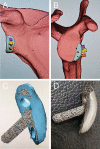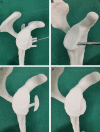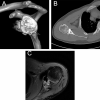Reconstruction of recurrent shoulder dislocation with glenoid bone defect with 3D-printed titanium alloy pad: outcomes at 2-year minimum follow-up
- PMID: 38166887
- PMCID: PMC10763388
- DOI: 10.1186/s12891-023-07148-5
Reconstruction of recurrent shoulder dislocation with glenoid bone defect with 3D-printed titanium alloy pad: outcomes at 2-year minimum follow-up
Abstract
Background: To evaluate the outcome of shoulder arthroscopy-assisted implantation of three-dimensional (3D)-printed titanium pads for recurrent shoulder dislocation with glenoid bone defects.
Methods: From June 2019 to May 2020, the clinical efficacy of 3D printed titanium pad implantation assisted by shoulder arthroscopy, for the treatment of recurrent shoulder dislocations with shoulder glenoid defects was retrospectively analyzed. The American Shoulder and Elbow Surgeons (ASES) shoulder, Rowe, and Constant scores were recorded before surgery and at 3 months, 6 months, 1 year, and 2 years after surgery. 3D computed tomography (CT) and magnetic resonance imaging were used to evaluate the location of the glenoid pad, bone ingrowth, joint degeneration, and osteochondral damage.
Results: The mean age of the 12 patients was 21.4 (19-24) years and the mean follow-up time was 27.6 (24-35) months. The Visual Analog Scale score significantly improved from 5.67 ± 1.98 preoperatively to 0.83 ± 0.58 postoperatively (p = 0.012). The postoperative ASES score was significantly increased to 87.91 ± 3.47 compared with preoperative ASES score (46.79 ± 6.45) (p < 0.01). Rowe and Constant scores also improved from 22.5 ± 12.34 and 56.58 ± 7.59 preoperatively to 90.83 ± 4.69 and 90.17 ± 1.89 at 2 years postoperatively, respectively. CT performed 2 years after surgery showed that the pad perfectly replenished the bone-defective part of the shoulder glenoid and restored the articular surface curvature of the shoulder glenoid in the anterior-posterior direction, and the bone around the central riser of the pad was tightly united. Magnetic resonance imaging 2 years after surgery showed that the humeral head osteochondral bone was intact, and there was no obvious osteochondral damage.
Conclusions: 3D printed titanium pads are a reliable, safe, and effective surgical procedure for treating recurrent shoulder dislocations with glenoid bone defects.
Keywords: 3D-printed titanium alloy pad; Glenoid bone defect; Recurrent shoulder dislocation.
© 2024. The Author(s).
Conflict of interest statement
The authors declare no competing interests.
Figures






Similar articles
-
[Radiographic study of effect of lateral placement of bone graft on shoulder joint degeneration after modified arthroscopic Latarjet surgery with elastic fixation].Zhongguo Xiu Fu Chong Jian Wai Ke Za Zhi. 2021 Apr 15;35(4):414-419. doi: 10.7507/1002-1892.202011089. Zhongguo Xiu Fu Chong Jian Wai Ke Za Zhi. 2021. PMID: 33855823 Free PMC article. Chinese.
-
[Application of LU-tarjet congruent-arc technique in treatment of recurrent shoulder dislocation with huge glenoid defect].Zhongguo Xiu Fu Chong Jian Wai Ke Za Zhi. 2024 Jun 15;38(6):672-678. doi: 10.7507/1002-1892.202403039. Zhongguo Xiu Fu Chong Jian Wai Ke Za Zhi. 2024. PMID: 38918186 Free PMC article. Chinese.
-
Clinical and Radiological Outcomes in Patients With Anterior Shoulder Instability and Glenoid Bone Loss after Arthroscopic Free Bone Block Combined With Dynamic Anterior Stabilization.Am J Sports Med. 2023 Jan;51(1):187-197. doi: 10.1177/03635465221137883. Epub 2022 Dec 5. Am J Sports Med. 2023. PMID: 36468855
-
Outcomes are comparable using free bone block autografts versus allografts for the management of anterior shoulder instability with glenoid bone loss: a systematic review and meta-analysis of "The Non-Latarjet".Knee Surg Sports Traumatol Arthrosc. 2021 Jul;29(7):2159-2174. doi: 10.1007/s00167-020-06194-z. Epub 2020 Aug 4. Knee Surg Sports Traumatol Arthrosc. 2021. PMID: 32749510
-
Iliac bone-block autograft for posterior shoulder instability.Orthop Traumatol Surg Res. 2009 Apr;95(2):100-7. doi: 10.1016/j.otsr.2008.09.008. Epub 2009 Mar 21. Orthop Traumatol Surg Res. 2009. PMID: 19332402 Review.
References
-
- Kawasaki T, Ota C, Urayama S, Maki N, Nagayama M, Kaketa T, Takazawa Y, Kaneko K. Incidence of and risk factors for traumatic anterior shoulder dislocation: an epidemiologic study in high-school rugby players. J Shoulder Elbow Surg. 2014;23(11):1624–30. doi: 10.1016/j.jse.2014.05.007. - DOI - PubMed
-
- Piasecki DP, Verma NN, Romeo AA, Levine WN, Bach BR, Jr, Provencher MT. Glenoid bone deficiency in recurrent anterior shoulder instability: diagnosis and management. JAAOS-Journal of the American Academy of Orthopaedic Surgeons. 2009;17(8):482–93. doi: 10.5435/00124635-200908000-00002. - DOI - PubMed
MeSH terms
Substances
Grants and funding
LinkOut - more resources
Full Text Sources
Medical

